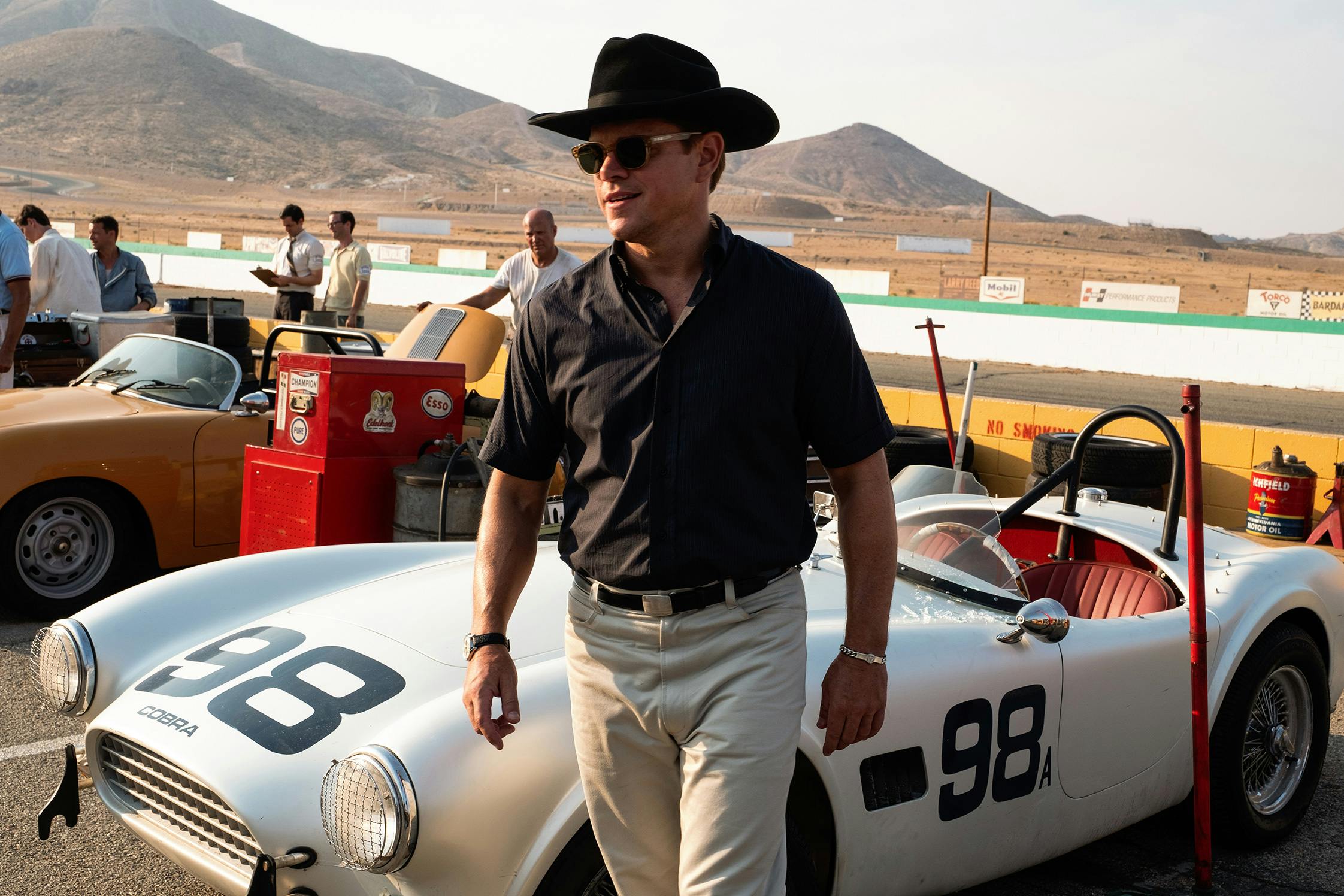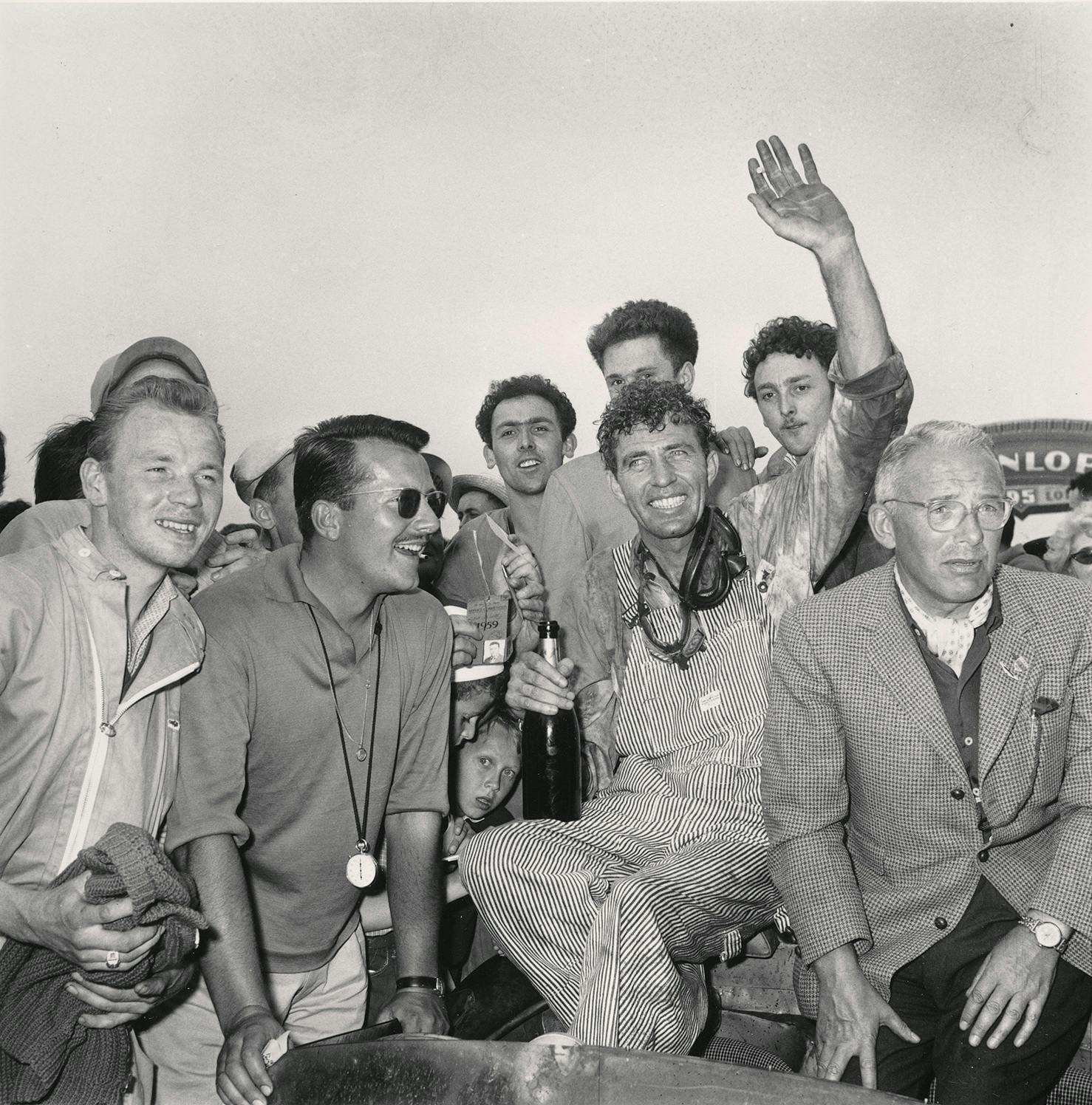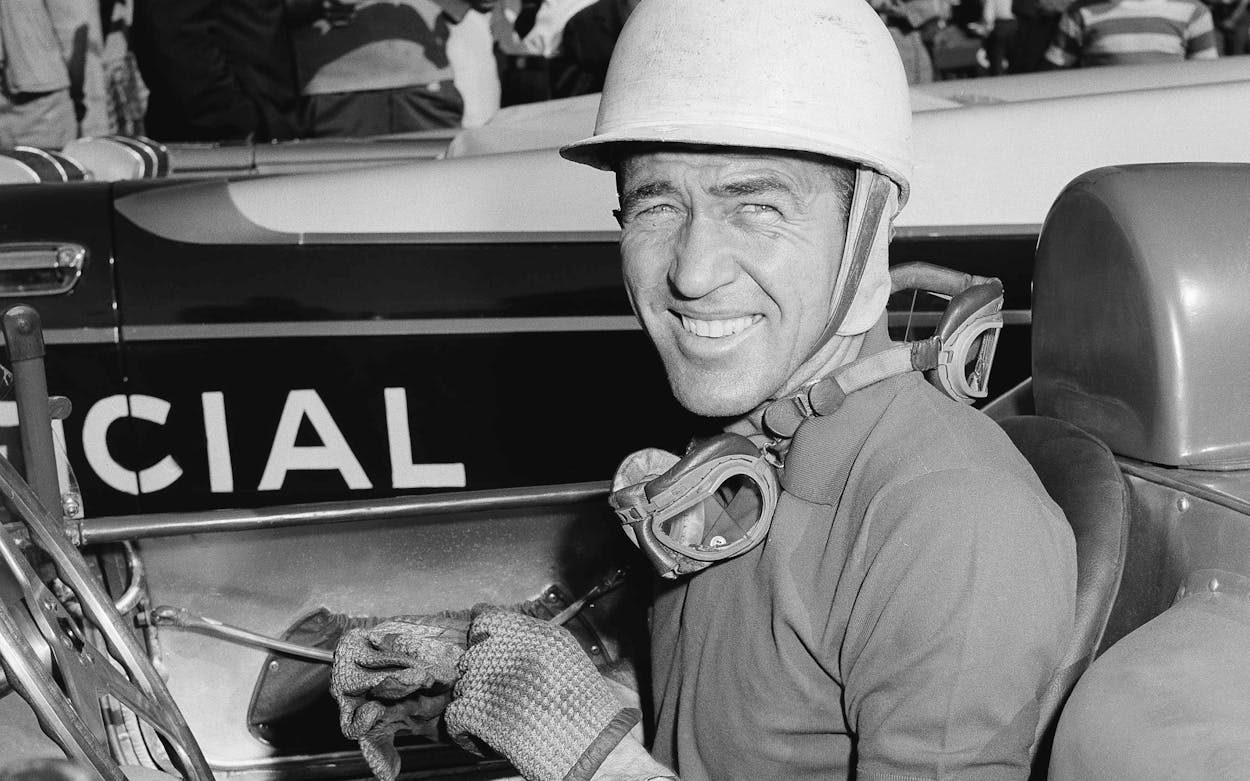The invention of our meanest, fastest sports cars—and the ingenious thinker who crafted them—could all be on account of a batch of dead chickens. Before he became an automobile developer, Dallas’s Carroll Shelby was a farmer. His first year doing that, in 1949, had gone relatively smoothly. Then things took a turn for the worse with the chickens and he faced bankruptcy, with a wife and toddlers in tow.
Then a friend called about a new car he’d acquired—did Shelby want to come to Oklahoma and test her out? Shelby was gone in 60 seconds, arriving in his striped farming overalls. According to legend, one of the men there said: “My word, what an interesting kit to wear. You gotta stick with it. It’ll make you stand out,” as Shelby’s future teammate Jack Sears later told the BBC.
Shelby said his second batch of birds caught Newcastle disease, and they died. He struggled and supported his family while slipping away regularly to dominate races in which he drove his friends’ cars. In 1952 he piloted a Cad Allard to victory in a Sports Club Car of America race. Such conquests made his a familiar face at SCAA races by 1953—that year he seized a short-notice invite from the club to a competition that sent him rushing from farm to racetrack in his work clothes. “The striped bib coveralls caused more publicity than his racing record,” Motor Trend magazine noted. And so the story goes that the overalls became his trademark attire. But Larry Lavine, Shelby’s erstwhile son-in-law, friend, and founder of Dallas’s inaugural Chili’s restaurant on Greenville Avenue, says it’s all urban legend. Lavine often visited Shelby’s East Texas ranch, where he eventually retired and raised miniature horses. “You never knew what he was going to do,” Lavine says. “The overalls and all—that’s the folklore. But it didn’t happen like that.”
Still, if not for this poultry plague, Matt Damon might not be portraying the Texan automobile developer in Ford v Ferrari, a recently released film that’s a 2020 Oscar contender. An early scene shows a doctor telling a middle-aged Shelby that he’ll die (from a persistent heart condition he’s battled since childhood) if he keeps driving. In spring 1962, Shelby—by then retired and running a high performance driving school—meets Lee Iococca (played by Jon Bernthal), “father of the Ford Mustang” and head of Ford’s high-performance division. The two share a common goal—to dethrone Enzo Ferrari (Remo Girone), recent five-time champion of the 24 Hours of Le Mans. Shelby had driven an Aston Martin to victory in the 1959 Le Mans, beating team Ferrari (which had previously turned him down as a driver). And, as a rule, Americans did not win Le Mans.
While troubleshooting ongoing issues with the bigwigs at the monolithic Ford Motor Company, Shelby engineers create perhaps the most powerful, fastest-ever machine on wheels for the time. And Shelby knows who he needs behind the wheel: the craggy, headstrong Ken Miles (played by Christian Bale), who the brass at Ford did not exactly consider a good “face” of the company. To make a point, Shelby chauffeurs Henry Ford II on a terrifying 200-plus-miles-per-hour track test run to convince the exec that not just anyone can drive this thing—they need Miles—and it makes for one of the film’s more compelling scenes. The project for Shelby, Miles, and the rest is jammed with balancing acts between virtue and agonizing compromise, heartache, frustration, friendship, enlightenment, and euphoria—all in the name of winning.
But the tall tales, exaggerations, and fabrications about Shelby’s life in Texas abound, living well outside the movie’s lines. “He lived a lot of lives, a little more than a cat,” says Carroll’s grandson, Aaron Shelby. While Carroll Shelby may be a household name among car enthusiasts and around his hometown of Dallas, Ford v Ferrari—with Damon’s comedic timing and manifestation of the good-hearted demigod of driving who could also land a plane (if shakily)—could very well solidify Shelby’s place in history as a king of the road.

Shelby discovered his taste for adrenaline early. His first rides were with his dad, a rural mail carrier in Leesburg (where Shelby was born) who transferred to a Dallas USPS job. “Faster, faster!” a young Shelby urged his dad, who was driving the truck. Shelby got his driver’s license at age fourteen, and on his inaugural licensed spin, Dallas police pulled him over on East Pike (“It was the best street,” Shelby once said) doing 80-plus miles per hour. He was grounded “forever,” he told me in 2009. “I was itching all the time to see how high I could fly!”
The historian Bradley Sue Howell, from Shelby’s alma mater Woodrow Wilson High School, says the famous alum endured many a dressing down by principal “Pop” Ashburn for racing his “hot rod” up Glasgow Drive, in front of the school. “He’d tell Carroll ‘you need to get a life,’” Howell says. Shelby told me: “I was a bad student. I was always in his office for skipping school.” A heart murmur meant he couldn’t participate in most sports, but he was on the high school golf team. Fellow Woodrow Wilson High classmate Randy Patterson swears that Shelby could have been an elite golfer, had he kept at it. He caddied at nearby Tenison Park Golf Course for extra cash, and raced Midget cars around a track at Fair Park until his dad made him quit. He was one of two kids who failed to graduate with his class of four hundred, and he attended summer school. (Nonetheless, he was inducted into Woodrow’s hall of fame, alongside the likes of Pulitzer winner Lawrence Wright and Blazing Saddles‘ Burton Gilliam.)
Shelby, who had grown up watching the planes over Love Field in awe, went on to study aeronautical engineering in the early forties. This was just before joining the war effort at eighteen, as a U.S. Army Air Corps flight instructor and test pilot. Following his return, he ran a car lot near Southern Methodist University—today, it’s an apartment complex called The Shelby. In the next few years he tried, to name a few, a dump truck business, roughnecking, and hawking a product called Pit Stop (“A Real Man’s Deodorant,” according to old print advertisements). By that point, he had already abandoned several potentially successful ventures, the oil rigging, dump-trucking and all. But he always had an idea, a next move.
With his early racing in his buddy’s humble MC, first in amateur unofficial races and later in real road races, he caught the attention of Aston Martin in the fifties. Now he really had a chance to show his chops, competing in Formula 1 in 1958-59 and participating in eight world championship races.
When Shelby and his teammate Roy Salvadori won the now world-famous 1959 Le Mans, no one, except perhaps Shelby, suspected he was nearing the end of his racing days. Cars and competition had Shelby’s heart. The desire nearly killed him—there were broken bones, contusions, a shattered elbow, and multiple surgeries. At one point he even drove with his arm in a fiberglass cast, his hand taped to the steering wheel. But the organ had it out for him in less metaphorical ways. On December 3 and 4, 1960, Shelby entered his last race. He won the overall 1960 USAC driving championship. He had been reticent about his hurting chest, and how he’d been slipping nitroglycerin pills under his tongue in races. The doctor told him he’d die if he kept at it.

Years later, in 1990, a 34-year-old man died of an aneurysm, and Shelby received his heart. In 1991, Shelby was inducted into the International Motorsports Hall of Fame. The same year he launched the Carroll Shelby Children’s Foundation to fund heart transplants for indigent children. He died in 2012; an obituary noted that he was one of the world’s longest living transplant recipients. Jay Leno hosted the memorial service, where a young woman spoke not only about receiving a transplant from the charity, but of how Shelby kept in touch with her the rest of his life. “I think my grandfather would want to be remembered for the latter more than anything,” says Aaron Shelby.
On a recent fall afternoon, Aaron Shelby sits on the sixth floor of LegacyTexas, where he’s now the executive vice president. Soon, he has to head to Los Angeles for a red carpet premiere; for now, he scrolls through a gallery of stills and video clips from the Hollywood film made about his grandfather’s life. He then plays the trailer for the documentary he’s making with Adam Carolla’s Chassy Media, and pulls out the poster mock-up for a forthcoming Carroll Shelby documentary.
Patrick Shelby, Aaron’s dad, introduced eight-year-old Aaron to racing; the kid fell in love with the sport. But back then, he knew the man who set 70 new speed records at Bonneville Flats, the dude who dreamed up the Shelby Cobra, only as Grandpa, the guy who swooped by bearing candy—the whimsical patriarch who brought everyone to his Nevada apartment and spent hours splashing around in its pool.
Young Aaron began researching his grandfather’s racing history only when Carroll Shelby teamed up with Lee Iacocca and Chrysler in 1982, making big news in the business and auto world. Iacocca became president of Chrysler when Ford fired him, and he brought in Shelby to add a bit of pizzazz to the operation—the 1983-86 Shelby Charger coupe and Omni GLH (“Goes Like Hell”) hatchback were the initial fruits of the merger. Basically, Chrysler’s workaday front-drive subcompacts got the Shelby treatment.
When Aaron heard that a major movie about his grandfather’s Ferrari rivalry was in motion, he says he didn’t think much of it since the project had been in the works for about two decades. “For five or so years we were told Brad Pitt and Tom Cruise were tied to it,” Aaron says. “Nothing came of it. In 2017 when it came up again, we put it in the same box.”
By then, he had joined the board of Carroll Shelby International and was committed to honoring his grandfather’s legacy. Then something shifted. “One of our partners, Mike Holmes, who does vintage design, was commissioned to build replicas of cars for the movie,” he says. That’s when he thought that this thing might really happen. (Later, Aaron bought the car Damon drives in Ford v Ferrari, and his brother bought the one Christian Bale drove as Ken Miles.)
But whom do you cast to play the esoteric Carroll Shelby? Aaron says he wasn’t sure at first that Matt Damon could pull it off. But Damon “made it work,” he says, and captured his late grandfather’s distinctive personality in the process. That’s largely to the credit of director James Mangold, who steers a story about camaraderie, friends and frenemies, and people trying to be the best. He likes making moviegoers care about niche worlds: it’s what makes Ford v Ferrari attractive to an audience who might not care at all about cars. “The whole way in was about people who collaborate and cooperate to make something that’s bigger than they are, and that’s kind of what we all spend our lives doing,” Damon said in a Q&A following the film’s international premiere at this year’s Toronto International Film Festival. “And so I could really relate to Carroll Shelby.”
That mythology is perhaps why people keep making films about Carroll Shelby—and at least two musicians wrote songs about him. Carol Connors’s “Hey Little Cobra,” which she wrote in return for a Cobra of her own, topped the Billboard charts at number four in 1963 until it was knocked off by the Beatles. “I hated the Beatles ever since,” Shelby recalled in a BBC interview. Hey, he liked to win.
- More About:
- Film & TV






